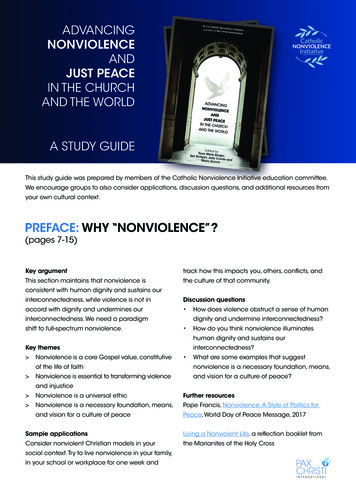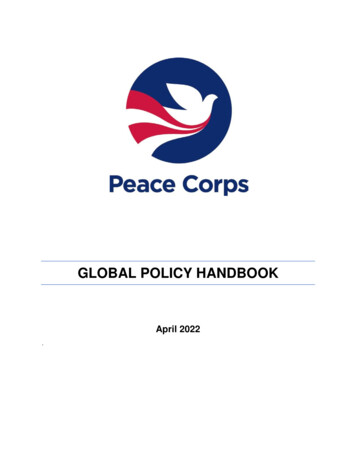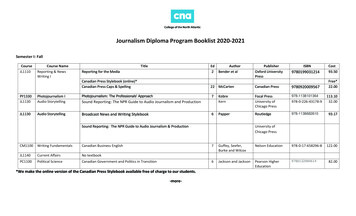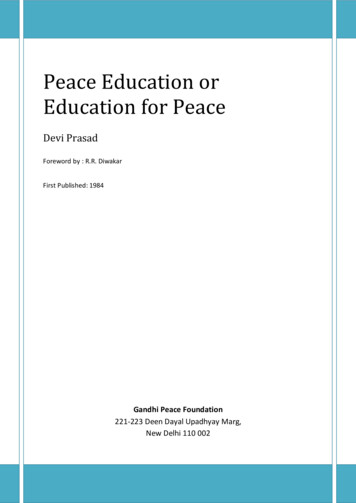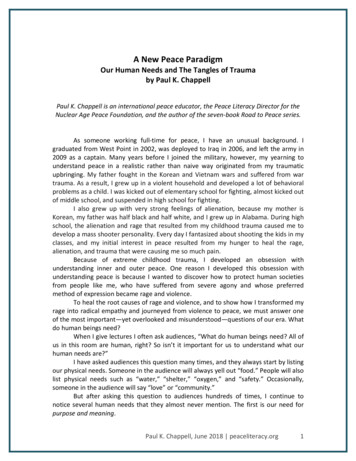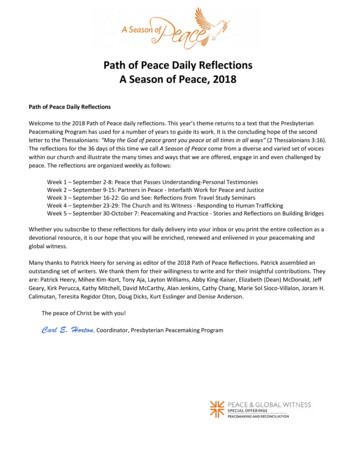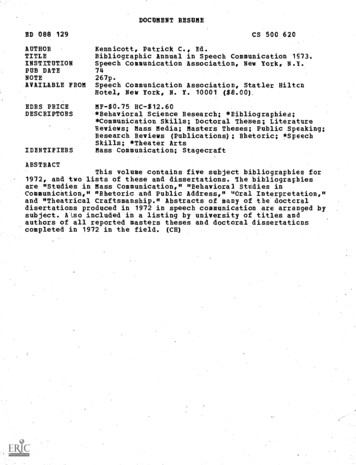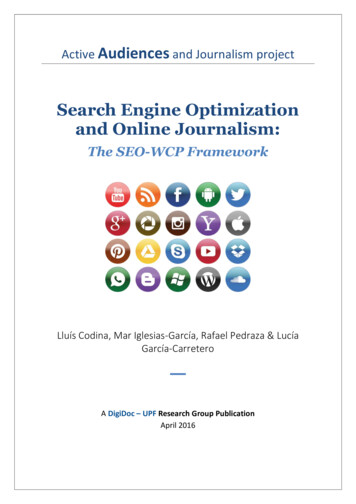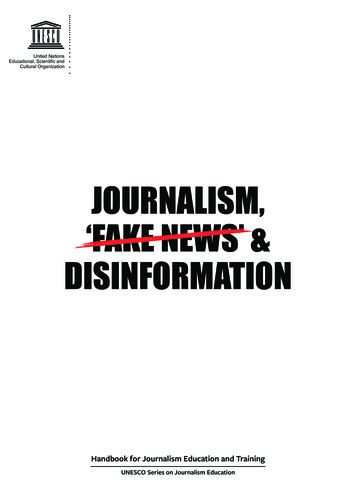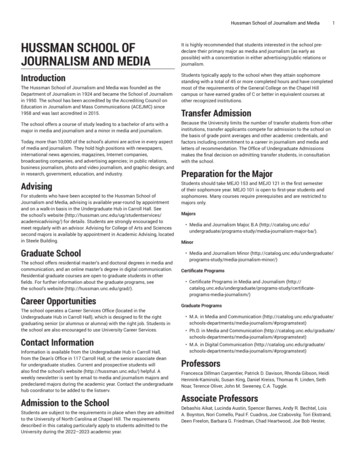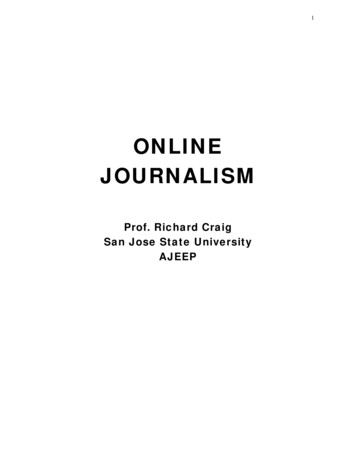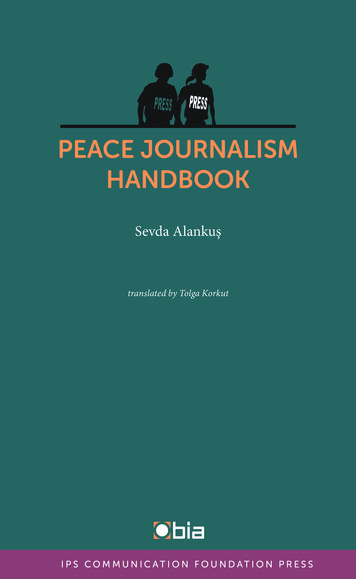
Transcription
PEACE JOURNALISMHANDBOOKSevda Alankuştranslated by Tolga KorkutI P S C O M M U N I C AT I O N F O U N D AT I O N P R E S S
PEACE JOURNALISM HANDBOOKSevda Alankuştranslated by Tolga KorkutIPS COMMUNICATION FOUNDATION PRESS
Barış Gazeteciliği Elkitabı IPS Communication FoundationFirst Edition: March 2016IPS Communication FoundationFaik Paşa Yokuşu No: 37/7-8 Kat: 334430, Beyoğu, İstanbulTel: 90 212 251 1503Faks: 90 212 251 1609e-mail: bia@bianet.orgwebsite: www.bianet.orgPublishing House Certificate No: 26549 This book is released with financial support ofSwedish International Development Cooperation Agency andConsulate General of the Kingdom of the Netherlands.IPS Communication Foundation is the sole owner of the production.Contents of this publication can in no way be taken to reflect the views ofSwedish International Development Cooperation Agency andConsulate General of the Kingdom of the Netherlands. Book design and implementation: Emre Senan, Recep Daştan, Ali Seçkin KarayolOffset Preparation: Metis Yayıncılık Ltd.Print and Bind:Yaylacık Matbaacılık Ltd. Topkapı, İstanbulTel: 0212 567 8003Print House Certificate No: 11931ISBN-13: 978 605 85516 1 9PEACE JOURNALISM HANDBOOKBarış Gazeteciliği ElkitabıSevda Alankuştranslated by Tolga Korkut
Sevda AlankuşTraining Advisor for BİA (Independent Communication Network), Deanof Kadir Has University's Faculty of Communications (Prof. Dr.).She graduated from Ankara University's Faculty of Political Science,completed her masters and doctorate degrees in the field of PoliticalScience and Public Administration in the same university. She continuedher academic studies in Leeds University from 1988-89.Between 1982-1999, she worked in Ege University and AnkaraUniversity as an academic member in the Faculties of Communications.She received her titles of associate professor and professor in the fieldof Communication Sciences.She founded the Communication and Research Center for Peace in theperiod when she was the dean of Eastern Mediterranean University'sFaculty of Communication and Media Studies (1999-2008).CONTENTSPreface to a Peace Journalism Handbook by Susan Dente Ross 9Preface: From the IPS Foundation 15On the choice of peace journalism and the handbook 23Why another kind of journalismand what kind of peace journalism? 24What is peace journalism? 28Good journalism or peace journalism? 32Peace journalism in Turkey! 35Expanding the boundaries of peace journalism:Just-peace journalism 38Why "(an)other" and feminist ethics for peace journalism? 40Newsworthiness in conventional journalism 47Since 1999, she has been the editor of IPS Foundation publicationsas the Training Advisor for the Independent Communication Network(BİA). Among her fields of research are alternative media, peacejournalism, feminist media criticism.Redefining newsworthiness 50News sources in conventional journalism and need for enriching 66Editorial values: so-called objectivity, impartiality, balance 71Redefining the editorial values 74Tolga KorkutWorked as an editor, reporter, announcer and manager for variousmedia groups in Turkey. He was an editor for bianet in the period2005-2010. Translated several articles for bianet, Açık Radyo, NationalGeographic Türkiye. Translated film subtitles for Digiturk and variousdocumentaries about ecology. His main fields of interest in journalismare human rights, labour rights, gender, discrimination, diversity,ecology, non-violence and non-violent communication, and peacejournalism.5W 1H, reverse pyramid of conventional journalismand their problems 77News language and discourse in just-peace journalism 80News framing and writing in situations of conflict and war 90War and peace journalism via photography 101Things to consider choosing the photographsin just-peace journalism 111Once again on peace journalism,the need for it and how to do it 114Bibliography 134Index 140
8PEACE JOURNALISM HANDBOOK9Preface to A Peace Journalism HandbookBy Susan Dente RossWhile the date of conception of Peace Journalism is somewhat murky –as are many beginnings – it is clear today that the field has reached arobust and active maturity. Whether viewed as a challenging alternative to biased or pro-stasis mainstream journalism, as a broaderand more balanced platform for myriad perspectives and viewpoints, as a “possibility of another kind of journalism” content andstructure, or as an antidote to “negative” news focused on conflict,crime, and celebrity imbroglios, Peace Journalism stands upon thetheory that the free flow of accurate information to the people fromall corners of the world is the foundation of an informed citizenryand to fair and just systems of government.In the past few decades, some have credited Peace Journalism (inpartnership with the much-ballyhooed role of social media) withpropelling the Arab Spring, supporting the non-violent struggle ofPalestinians in the West Bank, and improving peace negotiationsin Cyprus and elsewhere. But while the media clearly contributeto public attitudes, beliefs, and knowledge, the power of the newsmedia (let alone the more specific combination of practices embraced by Peace Journalism) to initiate or alter group behavior andinstigate or end mass violence is quite uncertain. Rather, the writersof this workbook and other advocates of Peace Journalism hope thatPeace Journalism will enhance the ability of all – governors and
10PEACE JOURNALISM HANDBOOKgoverned, worker and owner, female or male or transgendered – tobetter see themselves and their world in order to envision new roadstoward justice and peace for all.It is clear, then, that this review and handbook of Peace Journalism is timely. It is prescient to reconsider this field as the worldfaces unanticipated waves of “fake news,” the challenge of massmigrations, the evisceration or fraying of human rights around theglobe, and elections that place increasing power in the hands of afew who wish to pull away from multinational alliances, increasethe stigmatization of the Other, and swell a bellicose chorus ofaggressive nationalism.The intentional infusion of both feminist theory and rights-basedjournalism into this consideration of Peace Journalism offersa welcome clarification of several areas that have plagued thedevelopment of the field. First and foremost, it provides a muchneeded critical basis for identifying and justifying why allperspectives and versions of events are not equally important. Thisvolume’s clear focus on feminist theory and the critique of privilegeembedded in traditional news narratives and in language itself– their structure, syntax, vocabulary, inflection, and blind spots –targets for reconsideration the traditional and systematic silencing,stigmatization, and disempowerment of women, yes, but also ofidentified “others” whose very existence might pose a challengeto established order. This book’s embrace of feminist theory urgesPeace Journalism to act consciously and consistently as an antidoteto the dominant rhetoric of a specific time and place by embracingthe language of the Other.Such a perspective of conscientious response to systematic exclusionor underrepresentation replaces the traditional journalist’s mantraof balance with a more specific and located idea of equity. At leasthalf a century of research and experience now demonstrate howtraditional journalism’s call for similar and balanced treatment ofPEACE JOURNALISM HANDBOOK11competing perspectives produced narratives in which those relegated to the margins of power were allowed primarily to respond tothe vision and interpretation of the powerful. In contrast, feministtheory calls upon communicators to allow the women, the people ofcolor, the disfavored of every ilk to craft the central portrait and toask those in power to respond by actively changing the conditionsof this reality.Whereas traditional journalism offered a formulaic approach to thework of reporters, feminist Peace Journalism offers no such simple,one-size-fits-all formula for newsgathering and reporting. Instead,a feminist practice is both highly nuanced and situational. It asksnot that practitioners systematically favor the disfavored. Instead,it encourages journalists to both recognize and understand themyriad realities of life in any given community at a very particulartime. To do this, those who report the news must endeavor to findand attend to precisely those individuals who do not have equalopportunity, access, or power in that specific situation and to assurethat their voices are amplified sufficiently to expand the dialogue.The complementary but quite distinct and less-established approachof rights-based journalism eschews traditional journalism’s focuson some imagined and idealistic “objectivity.” Here again, muchresearch and practice have made clear that objectivity is a fictionthat can as easily misguide as guide journalists toward effectiveand robust reporting. When we aim to be objective, we too oftenproject our own experience and values into the events we report.We tend to see what is familiar as true and what is different orfrightening as less credible. Given objectivity’s imperfectionas a journalistic model, a rights focus encourages journalists torecognize their personal flaws and biases as well as the systematicinfluences of powerful elites and to work toward reporting thatprivileges fundamental rights above other values.In this light, the role of a journalist goes beyond identifying and
12PEACE JOURNALISM HANDBOOKreporting the facts toward careful and systematic scrutiny of howthose facts undermine or support foundational human rights.Thus, a rights-based report on war would not focus exclusively, oreven primarily, on the events between the combatants but wouldlook beyond, around, and beneath those events to examine theirongoing impact on the people and their lives. In an active conflict,a rights-based journalist asks not, “Who is winning?” or “Wholost more lives?”, but “What is happening to the community?”,“How secure are the people?”, “Do the residents have access to food,water, shelter, and medical care?”, etc. In this way, a rights-basedjournalist illuminates the ways in which the exercise of militarypower is often oblivious to the rights to life and liberty of the peopleand highlights how war rarely affects those who chose to wage it butoften (always?) devastates the bystanders who traditional journalistsgenerally recognize only as unnamed “casualties.”It is clear that each and all of these approaches to Peace Journalismpresent new challenges for practitioners. It is fair to say that each asksa great deal in the way of growth and introspection from adherents.Each encourages journalists to increase their ability to step outsidetheir own experience, to become more self-aware and empathetic,to move beyond their circle of comfort to seek to embody other’sexperiences, to overcome cultural, political, religious, ethnic andother barriers. This is a great deal to ask. Indeed, it may be toomuch to expect. And yet, while it is important to recognize thatnone of these approaches – Peace Journalism, feminist Peace Journalism, rights-based Peace Journalism, or some combination ofthem – is perfect, it is equally important to recognize the enormousbenefits they can bring to our ability to understand, share, and growtogether. It is important to support their development as an alternative and/or complement to traditional mainstream journalism.This Peace Journalism Handbook takes a major step toward thatsupport. It opens with a poignant reminder of the work of the IPSPEACE JOURNALISM HANDBOOK13Foundation and the ongoing events in Turkey and well beyondthat propel its mission. It then provides a very brief overview ofhow the handbook came into being before touching upon somekey documents on the principles and responsibilities of journalists.The heart of the handbook begins with a discussion of the natureof Peace Journalism: Why is it needed? What is it? How is it newor different? The handbook then turns to the specific applicationof Peace Journalism in Turkey before exploring how a rights-basedapproach and an embrace of feminist theory can enrich and expandthe practice. This deep foundation establishes a springboard formore detailed and systematic scrutiny of how to practice PeaceJournalism that encompasses the definition of what constitutesnews; who and what are the sources to be relied upon; what valuesundergird and drive the practice; what structures and assumptionsare encouraged; how a new language can improve our understanding; what can be done to work within the myriad challenges ofactive conflict or war; why photographs matter so much and how toimprove the practice of photojournalism; and – to close – a reviewof why we need peace journalism and how you can help it grow.This Peace Journalism Handbook makes an extremely valuable contribution to the field and to all of us. It can, and should, be read byevery one of us. Every citizen everywhere on earth should use thisnew and encouraging critique of where, why, and how mainstreamjournalism has lost its way as a wake-up call to individual actionand increased responsibility. We should bask in the light it shedson how each of us can better consume, understand, and respond tothe news narratives that shape our view of ourselves and the worldin which we live. I hope we will not only read it but take its call toheart and act upon it.Secondly, this book can, and should, be read by all those who todaywork as or train journalists. It offers an essential guide to betterpractices and more critical approaches to how those in the field view
14PEACE JOURNALISM HANDBOOKPEACE JOURNALISM HANDBOOK15and conduct your work. In some ways, this volume helps to placeworking journalists more solidly in the moment. It helps reducethe distance between the observer and the observed by putting ourshared humanity and our common values and truths center stage. Inthis way, it can help journalists move away from zero-sum thinkingtoward a notion of a truly global common good.Finally, because this handbook goes well beyond rich practical tips andhow-to’s, I hope it will evolve from a one-time read into the wellworn companion of every journalist in the field. When a workingjournalist faces self-doubt or unquestioning certainty about what isnewsworthy or how to present the events she sees, this volume offersitself as that reliable friend who will always ask the necessary andpointed question to encourage her to act from her best self. I hopewe all accept the challenge presented by this book. And I hope thatwe will each rise to meet it!Preface: From the IPS Communication Foundation*Dr. Susan Dente Ross is professor of English, director of the PaximPeace Research Group and Humanities Fellow at Washington StateUniversity. Leading international advocate for peace journalism,Dr. Ross has served as distinguished peace journalism fellow atuniversities in Canada, North Cyprus, Israel and Japan. She holdsa PhD in media law from the University of Florida and a master ofarts degree in journalism from the University of North Carolinaat Chapel Hill. Her work is widely published in journals of communication, critical studies, law, mass media, peace studies andpolicy. Dr. Ross is co-author of a top-selling textbook on the Lawof Journalism and Mass Communication (Trager, Ross, Reynolds,2018), two other books, numerous chapters in collections, and scoresof scholarly articles.Those newspapers with headlines generally reflecting the joy and goodnews of peace are dated March 2015. On February 28, 2015, members of the parliament from Peoples' Democratic Party (HDP) SırrıSüreyya Önder, Pervin Buldan and İdris Baluken met with DeputyPrime Minister Yalçın Akdoğan and Minister of the Interior EfkanAla in Dolmabahçe Palace. The meeting called, "the DolmabahçeDeal," was coded as "historic" the minute it was held. Kurdistan Workers' Party’s (PKK) leader Abdullah Öcalan's 10-point letter was read.Prime Minister Ahmet Davutoğlu said, "The process is settled on newgrounds now. The language of violence and arms in Turkey will endand the way for democratic politics will be paved." President RecepTayyip Erdoğan remarked on the importance of implementation.By Nadire MaterNow is the time for peace (Sabah), The Dolmabahçe agreement (Cumhuriyet), This is a call (Habertürk), Call for a farewell to arms (YeniŞafak), The debate over laying down arms in the resolution process(Zaman), The laying down arms process (Birgün), Spring of peace(Star), 10 principles call (Özgür Gündem), Lay down arms (Vatan),Call for a farewell to arms (Taraf), The first joint declaration (Evrensel), 10 points of polemic (Bugün), Giant step to peace (Akşam),Historic call (Takvim), Good things are happening (Güneş),Theydrew arms against the republic (Aydınlık), Coalition for the presidency (Yurt), Historic day (Türkiye), Assurance of separation fromAKP to PKK (Ortadoğu), Language of arms will end (Akit), Call toPKK to lay down arms (Milliyet)During the hours that the Dolmabahçe meeting was held, we lost the
16PEACE JOURNALISM HANDBOOKauthor Yaşar Kemal. The headline of daily Hürriyet was "May earthand sky cry" and the summary was as follows: "Yaşar Kemal endeavored a great deal for the resolution of the Kurdish question. Themaster author passed away on the day that a call was made to laydown arms within the resolution process".We started the Peace Journalism Project in those days when these headlines were flying in the air. In the following days, as we read the"peace-oriented" news stories of newspapers, with a few exceptions,I remember how we mocked those among us asking whether ourPeace Journalism book would be unnecessary, as we kept in mind howthe editorial choices and perspectives of the media could transformaccording to the government.After a few months had passed over those headlines, the media changed their position along with the government. In that one year, themassacres of Diyarbakır, Suruç, and Ankara occurred. Tahir Elçi,chair of the Diyarbakır Bar Association, was murdered. In the citiesof Kurdistan, hundreds died, and people were shut inside in theirhomes or were displaced to homelessness. The media became morepolarized; with media’s contribution, society did too.As long as wars, armed conflicts, and the numerous antagonisms in allareas of life prevail in this country and in the close or remote cornersof the earth, journalism will either play the role of establishing, “rightnow,” a just, equal, free, and peaceful life, or, unfortunately, it willcause these conditions to regress.That's why we invite journalists to a "disturbing" and pro-"right now"book and therefore to a journalism practice because we define journalism as a profession of "being unable to feel at ease" and "disturbing"the audience.If we speak about wars, we must always keep in mind those two sayingsthat remind us how much more important journalism becomes insuch situations. First is the saying attributed to Senator Hiram Johnson from when the USA entered the WWI: "The first casualty ofwar is the truth". The second saying belongs to David Lloyd George,the Prime Minister of Britain, who said, "If the people really knew[the truth] the war would be stopped tomorrow."PEACE JOURNALISM HANDBOOK17Hence, as "we", the independent journalists, academics and the localmedia gathered under the roof of the IPS Communication Foundation and established the Independent Communication Network(BİA) saying "another communication is possible," we always havetried to pursue "the truth". And we knew that pursuing the truthneeded to be "deal breaking" with regard to the thing that governments and the mainstream media subject to them presented as "thetruth," and we also knew that acting on the contrary meant "being anaccomplice" as stated by the Academics for Peace and the journalistwho supported them Journalism at bianet, which has been an important reference of journalism, has gone beyond itself for 16 years and has always progressedaccording to a rights-based and peace-oriented track. The dailyjournalism practices at bianet moved forward with questions andexaminations such as "how should that report be looked at from arights-based and a peace-oriented approach?", "should we use suchwording?" and, "should we use that photograph?" and settled on itstheoretical base via the discussions and studies that we tried to carryout in workshops, trainings and in the academy.Sevda Alankuş, the author of this book who is our training advisor, has aparticular position in that voyage. Apart from her, several academicsfrom Turkey and Cyprus whose names I cannot list one by one havebeen always with us. However, I particularly want to mention thenames İncilay Cangöz, who has always been just beside us both inthis project and in many other BİA projects, and Esra Arsan, whofirst mentioned peace journalism in her presentation entitled "Prowar and Pro-peace Discourse in the Media" at BİA basic journalismprograms' Journalism in Conflict and War topic.Peace Journalism Handbook is one of the 2015-2016 projects of IPSFoundation that gave life to bianet. In the archives of bianet, therehave been several texts already about what peace journalism means,how to behave with such a decision and the need for peace journalism via criticizing various news stories of the mainstream media,all of which could serve as guidance in the practice of journalism.However, within the scope of that recent project, resources aboutthe topic were both increased and gathered together in the PeaceJournalism Library 1. In the workshops we held, reporters, editors,ombudspersons, people advocating for the rights and the academics
18PEACE JOURNALISM HANDBOOKof communication got together and again discussed "the possibilityof another kind of communication" within the framework of peacejournalism. They dwelt on whether the structure of media ownership,thus the problematic "editorial independence", was an impassableobstacle against practicing peace journalism, how a journalist'sindividual stance could form her/his journalism or the news storiesshe/he covered (or did/could not covered), how people who coveredor tried to cover news within the framework of peace journalismachieved it and what kind of journalism language they consisted.Consequently, all those debates we had and the experiences sharedfrom the world and from Turkey made us think again, that puttingthe peace journalism choice into practice is not impossible, eventhough there are challenges.Now, we have a Peace Journalism Handbook. That work brings the literature of peace journalism into question by blending the "negative" and"positive" news story examples in practice within an interdisciplinaryreading. While doing this, it also constitutes a guide for those whowould like to practice peace journalism and, additionally, adds twoconsiderable theoretical contributions to the field. First, it convergesfeminist news criticism and peace journalism via the epistemologypresented by feminist philosophy, two things which have progressedwithout much contact for whatever reason, even though they havesimilar arguments about journalism. Second, it discusses rights-basedjournalism and peace journalism, underlining their relation withinthe framework of examples presented in its practice guide, a topicwhich has not been improved sufficiently even though their proximity has been emphasized in the international literature. Thus, boththe theory and the practice of peace journalism is enriched via therights-based journalism experience of BİA.Our handbook has a format enabling different readings. On one hand,by neatly presenting and comparing the relevant theories, it provides the opportunity to rethink conventional journalism and callsfor peace journalism by discussing why it should be an alternativechoice. On the other hand, since it is called a "handbook," it is also areference study. Therefore, it was written to be kept in hand, to be readas one would like – from the beginning or the middle or the end – andto be benefited from. It is enriched by sidebars and content consistingof definitions and articles in frames alongside positive and negativePEACE JOURNALISM HANDBOOK19examples. So, those sidebars might be helpful even when read ontheir own. Furthermore, repetitions weren't avoided on purpose. Insummary, the intention by all this was to have a handbook, whichwould be kept in hand, and be helpful in a versatile way both foracademic or practical goals.As our book was on its way to the print house, journalism and people'sright to information being almost denied was a topic on the agendanot only in Turkey but also in the world; by reported and unreportednews stories, 35 journalists in prison, journalists sued, pointed astarget, threats from power holders, dismissals of journalists, solidarity stands of journalists. Such situations are evidence that peacejournalism-oriented journalism is an ever urgent necessity. So, we,journalists who adopt peace as a norm, need to be the "deal breakers"of the present and also to behave with a new ethical responsibilitypursuing "the truth" which is essential for the news.With wishes and hope that the Peace Journalism Handbook will alwaysbe in our hands and practiced.* Nadire Mater is the chairwoman of IPS Communication Foundation,project advisor at Independent Communication Network (BIA) andbianet. Since 16 years, she has been seeking for the possibility ofanother communication built upon freedom of expression, humanrights, women, children and those who are pushed out of sight. Shewas a RSF Turkey representative between 1994-2000. Having workedat several local, national and international news organisations, she leftbehind 35 years in her journalism career. Her first book, "Mehmed’sBook" - a compilation of interviews with 42 young people who weredeployed to the hot clash zones in the southeastern Turkey undercompulsory drafting - has been published, banned and acquitted in1999. Later on, it was translated into English, German, Italian, Finnish and Modern Greek. Her second book "Street is Beautiful - WhatHappened in 68?" came out in 2009, published by Metis PublishingHouse.
PEACE JOURNALISM HANDBOOK21About the projectWe conducted the "Peace Journalism Handbook and Online Library"project with support from the Kingdom of the Netherlands ConsulateGeneral's Human Rights Program for the term 2014-2016. The supervisorfor the project was Sevda Alankuş, the coordinator was Begüm Zorlu.For the lead-up, academic member of İzmir University of EconomicsFaculty of Communication, Assistant Professor Doctor Altuğ Akınscanned nine newspapers' issues between September 1 - October 15,2014 and prepared a report according to the peace journalism criteriawith Faculty of Communication students Ayşenur Ölmezses Şentürk,Aslı Sayat, Begüm Yalçınkaya, Emre Ocaklı, Özge Sarı and Özgür Akşakar.Within the project, we conducted three workshops with journalistseditors2 (March 30, 2015), academics3 (April 18, 2015) and ombudspersons- representatives4 from rights organizations. Associate Professor Doctorİncilay Cangöz was the editor of the Peace Journalism Online Library.On November 21, 2015 we organized the meeting "Peace Journalism:A New Ethics, Practice and Journalism Education" with the Memory Center.In the meeting, under Murat Çelikkan's moderation, Prof. Dr. Sevda Alankuşand Dr. Rukhsana Aslam (New Zealand Auckland University of Technology) talked about peace journalism and carried on a discussion with theaudience.
PEACE JOURNALISM HANDBOOK23On the choice of peace journalismand the handbook This handbook was written about peace journalism in order to meet adual necessity. First, it aims to meet the academic need about peacejournalism which has been heard about, discussed, and practicednamely in Turkey and Northern Cyprus since the early 2000s, butthere wasn't an integral book study written in Turkish about it yet. Forthat need, the book brings together the theoretical debates, therebydrawing a zone for peace journalism and the field of critical sociology of news. The book intends to make a contribution to the fieldof peace journalism within the framework of feminist epistemologyand ethics and news criticism acknowledging that those haven't beenin contact sufficiently.The book approaches peace as a situation in which probable causesof war and conflict, poverty, discrimination, racism, xenophobia,violation of rights don't exist, or at least the pathways for humancreativity are paved in order to minimize those causes, and whereviolence isn’t a method to solve conflicts anymore, and, finally, as aprerequisite for a radically transformed democracy. Thus, it expandsthe definition of peace journalism through an approach based on theredefinition of the routine journalism concept and practice becomingrights-based and peace-oriented. It defines that expanded version ofpeace journalism as journalism based on ethics towards resolutionof social or inter-social tension or conflict issues by a rights-basedperspective and nonviolent methods. In other words, it enriches peacejournalism with the rights-based journalism perspective. It startsoff with the statement that such an ethical choice for the expandedversion of peace journalism is also an important political choiceparticularly in places where the public space is fragmented throughethnic, cultural, different faith groups and disbelievers and political
24PEACE JOURNALISM HANDBOOKpolarization intersecting with them. Therefore, it aims to meet theneed for a handy reference book for the journalists who wouldhave such an ethical and political choice. For that purpose, it givesexamples of conventional journalism's pro-war journalism incitingviolence, violating rights and of its alternative: peace journalism. Itpresents brief translated texts about what peace journalism is as wellas texts and guides compiled from various books, workshops, Independent Communication Netwo
This book is released with financial support of Swedish International Development Cooperation Agency and . PEACE JOURNALISM HANDBOOK PEACE JOURNALISM HANDBOOK. 12 13 Foundation and the ongoing events in Turkey and well beyond that propel its mission. It then provides a very brief overview of
